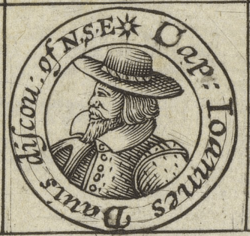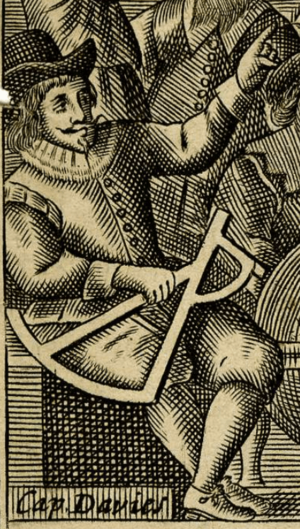John Davis (explorer) facts for kids
Quick facts for kids
John Davis
|
|
|---|---|

1624 miniature portrait from the title page of Samuel Purchas's collection of travel stories Purchas his Pilgrimes
|
|
| Born | Unknown date, c. 1550 Sandridge, Stoke Gabriel, England
|
| Died | 29 December 1605 (aged 54–55) off Bintan Island, East Indies
|
| Occupation | Explorer, navigator |
| Signature | |
John Davis (born around 1550 – died 29 December 1605) was a famous English explorer and navigator. He was one of the main navigators for Queen Elizabeth I of England. Davis led several trips to find the Northwest Passage. This was a sea route through North America to Asia. He also worked as a pilot and captain on voyages to the East Indies for both Dutch and English companies. In August 1592, he discovered the Falkland Islands.
Contents
Early Life and First Voyages
John Davis was born in the area of Stoke Gabriel in Devon, England, around 1550. He grew up in nearby Sandridge Barton. Some people think he learned his sailing skills as a child. He might have played with boats along the River Dart. He started going to sea at a young age. His childhood neighbors included Adrian Gilbert, Humphrey Gilbert, and their half-brother Walter Raleigh. He also became friends with John Dee early on.
In 1583, Davis began to suggest a trip to find the Northwest Passage. He spoke to Francis Walsingham, who was the queen's secretary. Two years later, in 1585, Walsingham agreed and paid for the trip. This journey followed Martin Frobisher's path to the east coast of Greenland. They sailed around Cape Farewell and then west towards Baffin Island.
In 1586, Davis went back to the Arctic with four ships. Two ships went to Greenland's eastern shore, where many icebergs broke off. The other two ships sailed into Davis Strait, which is now named after him. They went as far as 67°N latitude before ice blocked their way. One ship, the Sunshine, tried to sail around Greenland from the east but could not.
At first, Davis was friendly with the Inuit people. He brought musicians and had his crew dance and play with them. But this changed after the Inuit stole one of his anchors. They were probably upset because they had been interrupted during a religious ceremony. The Inuit also attacked his ships in Hamilton Inlet in Labrador.
A third trip in 1587 reached 72°12'N latitude and Disko Island. But strong winds forced them to turn back. On his way home, Davis mapped Davis Inlet on the coast of Labrador. The detailed logbook from this trip was used as a guide by other captains for many centuries.
Discovering New Lands
In 1588, John Davis likely commanded a ship called Black Dog. This ship fought against the Spanish Armada, a large Spanish fleet. In 1589, he joined the Earl of Cumberland on a trip to the Azores.
In 1591, he went with Thomas Cavendish on Cavendish's last voyage. They were trying to find the Northwest Passage from the western side of America. Cavendish's group returned without success. But Davis continued on his own. He tried to sail through the Strait of Magellan. Bad weather stopped him, but he discovered the Falkland Islands in August 1592. He was aboard his ship, the Desire.
His crew had to kill hundreds of penguins on the islands for food. But the meat spoiled in the warm tropical weather. Only 14 of his 76 men made it home alive from that difficult journey.
From 1596 to 1597, Davis sailed with Sir Walter Raleigh. He was the master of Raleigh's ship on trips to Cádiz and the Azores. From 1598 to 1600, he joined a Dutch trip to the East Indies as a pilot. He sailed from Flushing and returned to Middleburg. During this time, he carefully mapped and recorded many geographical details. He barely escaped danger from a surprise attack in Aceh on Sumatra.
From 1601 to 1603, he worked as the Pilot-Major for Sir James Lancaster. This was on the first voyage of the English East India Company. Davis was promised a large payment if the trip made a good profit.
Before leaving, Davis had told merchants in London that pepper could be bought cheaply in Aceh. But when the voyage returned, Lancaster complained that Davis had been wrong. The pepper was much more expensive and harder to find.
On 5 December 1604, Davis sailed again for the East Indies. He was the pilot for Sir Edward Michelborne. Michelborne had special permission from King James I to trade, even though the East India Company usually had a monopoly. On this journey, Davis was killed off Bintan Island near Singapore. He was attacked by pirates whose damaged ship he had just taken over. The pirates had acted friendly for several days before their surprise attack. Davis died almost immediately after the attack.
For centuries after his death, Dutch whalers were very important. Because of them, the towns along Greenland's western coast were called "Straat Davis." This was their name for the Strait. The name "Greenland" was used for the eastern shore. People wrongly thought this was where the Norse people had settled long ago.
Inventions
John Davis invented the backstaff and the double quadrant. This instrument was named the Davis quadrant after him. English sailors used it often for a long time. It remained popular even after Hadley's reflecting quadrant was invented.
Images for kids




